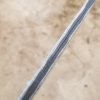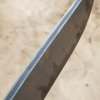- Joined
- Oct 1, 2009
- Messages
- 374
i have a question about heat treating San Mai it’s mild steel jacket with a layer of 15n20 on both sides and 1095 core. I was doing some reading and saw a lot of people seem to have them split after the quench. How should I go about this? Clay the spine? Edge quench? Do it like normal and do a full quench? Any help would be awesome thank you



